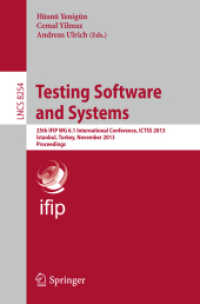- ホーム
- > 洋書
- > 英文書
- > History / World
Full Description
One of the earliest and most ambitious projects carried out by the Society of Jesus was the mission to the Christian kingdom of Ethiopia, which ran from 1557 to 1632. In about 1621, crucial figures in the Ethiopian Solomonid monarchy, including King Susenyos, were converted to Catholicism and up to 1632 imposing missionary churches, residences, and royal structures were built. This book studies for the first time in a comprehensive manner the missionary architecture built by the joint work of Jesuit padres, Ethiopian and Indian masons, and royal Ethiopian patrons. The work gives ample archaeological, architectonic, and historical descriptions of the ten extant sites known to date and includes hypotheses on hitherto unexplored or lesser known structures.
Contents
List of Figures
List of Tables
List of Contributors
1 Introduction: The Fieldwork and the Team
Víctor M. Fernández
2 The Infrastructure of the Mission: Convents, Palaces, and Temples
Andreu Martínez d'Alòs-Moner
2.1 The Jesuit Mission: From Oviedo to Mendes
2.2 Pedro Páez: The Experimental Phase, 1614-21
2.3 João Martins and the Indian Builders: The Patriarchal Phase, 1626-32
2.4 The Mughal Hypothesis
3 The Mission Sites
Víctor M. Fernández, Jorge de Torres, Carlos Cañete, and Andreu Martínez d'Alòs-Moner
3.1 Introduction
3.2 Fǝremona
3.2.1 Introduction and Historical Data
3.2.2 The Ruins
3.3 The Royal-Missionary Complex of Azäzo-Gännätä Iyäsus
3.3.1 Introduction
3.3.2 The Jesuit Church
3.3.3 The Fortified Enclosure
3.3.4 The Palace-Residence
3.3.5 The Hydraulic Systems
3.3.6 Gännätä Iyäsus after the Jesuits' Departure
3.3.7 The Material Culture
3.4 Gorgora, the "Phoenix of Ethiopia"
3.4.1 Gorgora in the History of the Jesuit Mission
3.4.2 Locating the Different "Gorgoras"
3.4.3 The Remains of Gorgora Nova
3.4.4 The Church of Gorgora Iyäsus
3.4.5 The Residence
3.4.6 The Material Culture
3.4.7 An Oral History about Gorgora Nova
3.5 Dänqäz
3.5.1 Introduction and Historical Data
3.5.2 The Palace
3.5.3 The Cistern
3.5.4 The Church
3.6 Däbsan
3.6.1 Introduction and Historical Data
3.6.2 The Ruins
3.7 Särka
3.7.1 Introduction and Historical Data
3.7.2 The Church of Virgin Mary
3.7.3 The Fortified Compound
3.7.4 The Main Building or "Palace"
3.7.5 The Subterranean Room or "Prison"
3.8 Ǝnnäbǝse—Märṭulä Maryam
3.8.1 Introduction and Historical Data
3.8.2 The Ruins
3.9 Abba Gǝš Fasil (Lǝǧǧä Nǝguś?)
3.9.1 The Historical Data
3.9.2 The Ruins
3.10 Qwälläla
3.10.1 The Historical Data
3.10.2 The Ruins
3.11 Hadaša
3.12 The "Lost" Missions
3.12.1 Tanḵa
3.12.2 Näfaša
3.12.3 Ankaša
3.12.4 Atḵäna
3.12.5 Märäba
3.12.6 Gäbärma
3.12.7 Dǝbarwa
3.12.8 Adegada
4 The Politics of Domination in Missionary and Royal Architecture
Carlos Cañete and Jorge de Torres
4.1 Introduction
4.2 Main Traits and Exceptions
4.3 Particular Interests, Global Consequences
4.4 The Material Accommodation of Power
4.5 The Regulation of Manners
4.6 From Materiality to Society
5 Conclusions
Victor M. Fernández
5.1 Introduction
5.2 Before the Mission
5.3 Before the Chunambo
5.4 After the Chunambo
5.5 After the Mission: The Origins of Gondärine Architecture
5.6 After the Mission: The "Closure" and Transformation of Jesuit
Structures
5.7 A Troubled Legacy
5.8 Conclusions
Appendixes
1 The Topography of the Mission Sites
Eduardo Martín Agúndez and Víctor del Arco Sanz
2 Three-Dimensional Laser-Scanner Reconstructions
Christian Dietz and Gianluca Catanzariti
3 3D Ground Penetrating Radar (GPR) Survey at the Azäzo—Gännätä Iyäsus Jesuit Mission
Gianluca Catanzariti and Christian Dietz
4 Technical Report on the Construction Materials, State of Conservation, and Restoration Proposals
Jorge A. Durán
5 Public Archaeology in Azäzo
Jaime Almansa
Bibliography
Manuscript Sources
Printed Sources
Secondary Literature
Index








